engine YAMAHA YZ85 2015 User Guide
[x] Cancel search | Manufacturer: YAMAHA, Model Year: 2015, Model line: YZ85, Model: YAMAHA YZ85 2015Pages: 88, PDF Size: 2.07 MB
Page 33 of 88
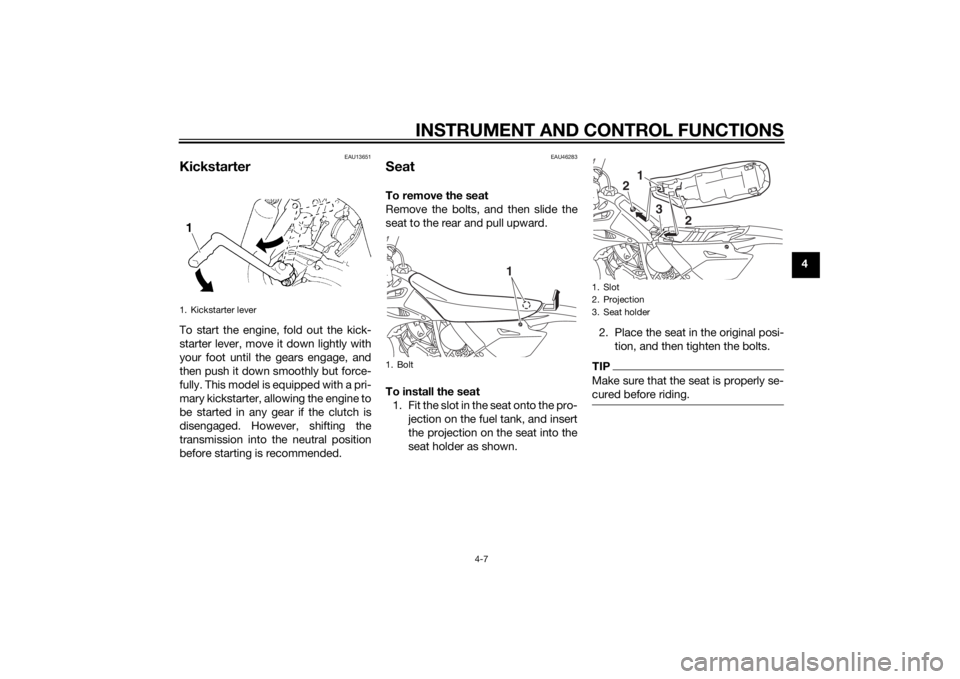
INSTRUMENT AND CONTROL FUNCTIONS
4-7
4
EAU13651
KickstarterTo start the engine, fold out the kick-
starter lever, move it down lightly with
your foot until the gears engage, and
then push it down smoothly but force-
fully. This model is equipped with a pri-
mary kickstarter, allowing the engine to
be started in any gear if the clutch is
disengaged. However, shifting the
transmission into the neutral position
before starting is recommended.
EAU46283
SeatTo remove the seat
Remove the bolts, and then slide the
seat to the rear and pull upward.
To install the seat1. Fit the slot in the seat onto the pro- jection on the fuel tank, and insert
the projection on the seat into the
seat holder as shown. 2. Place the seat in the original posi-
tion, and then tighten the bolts.
TIPMake sure that the seat is properly se-
cured before riding.
1. Kickstarter lever
1. Bolt
1
1. Slot
2. Projection
3. Seat holder
1
2
3
2
U1SN83E0.book Page 7 Monday, September 8, 2014 2:36 PM
Page 42 of 88

OPERATION AND IMPORTANT RIDING POINTS
6-1
6
EAU15952
Read the Owner’s Manual carefully to
become familiar with all controls. If
there is a control or function you do not
understand, ask your Yamaha dealer.
WARNING
EWA10272
Failure to familiarize yourself with
the controls can lead to loss of con-
trol, which coul d cause an acci dent
or injury.
EAU41308
Startin g an d warmin g up a
col d en gine1. Turn the fuel cock lever to “ON”.
2. Shift the transmission into the
neutral position.
3. Turn the starter (choke) on and completely close the throttle. (See
page 4-6.)
4. Start the engine by pushing the kickstarter lever down.
5. When the engine is warm, turn the starter (choke) off.TIPThe engine is warm when it responds
quickly to the throttle with the starter
(choke) turned off.NOTICE
ECA11043
For maximum en gine life, never ac-
celerate har d when the en gine is
col d!
EAU16661
Startin g a warm en gineFollow the same procedure as for
starting a cold engine with the excep-
tion that the starter (choke) is not re-
quired when the engine is warm.
Instead, start the engine with the throt-
tle slightly open.TIPIf the engine does not start after sever-
al kicks, try again with the throttle 1/4
to 1/2 open.
U1SN83E0.book Page 1 Monday, September 8, 2014 2:36 PM
Page 43 of 88
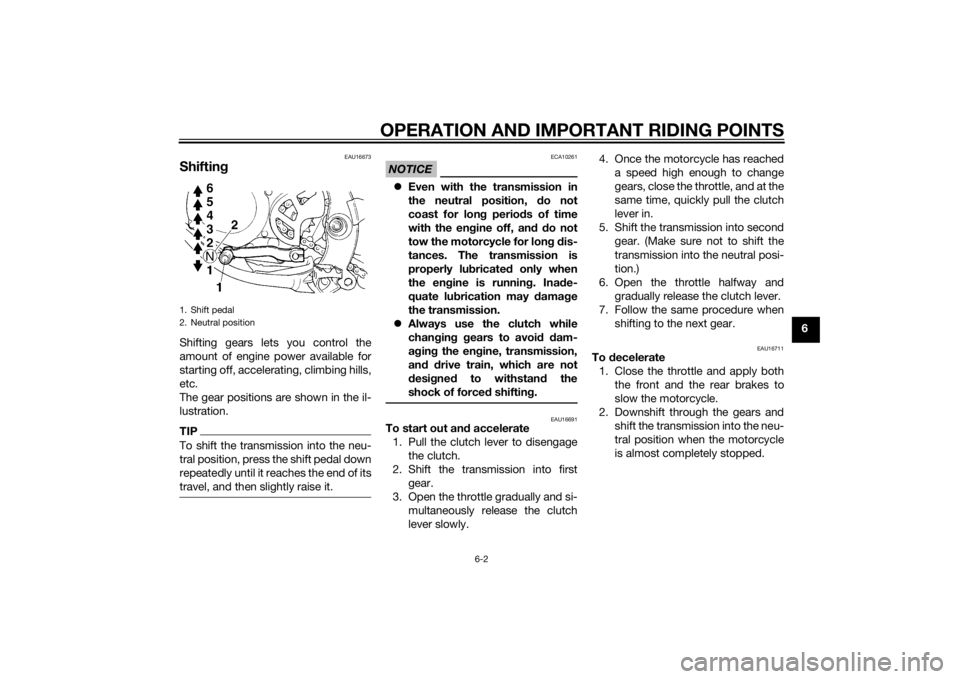
OPERATION AND IMPORTANT RIDING POINTS
6-2
6
EAU16673
ShiftingShifting gears lets you control the
amount of engine power available for
starting off, accelerating, climbing hills,
etc.
The gear positions are shown in the il-
lustration.TIPTo shift the transmission into the neu-
tral position, press the shift pedal down
repeatedly until it reaches the end of its
travel, and then slightly raise it.
NOTICE
ECA10261
Even with the transmission in
the neutral position, do not
coast for lon g period s of time
with the eng ine off, and d o not
tow the motorcycle for lon g d is-
tances. The transmission is
properly lu bricated only when
the en gine is runnin g. Ina de-
quate lu brication may damag e
the transmission.
Always use the clutch while
chan gin g g ears to avoi d d am-
a g in g the en gine, transmission,
an d d rive train, which are not
d esi gne d to withstan d the
shock of forced shifting.
EAU16691
To start out an d accelerate
1. Pull the clutch lever to disengage the clutch.
2. Shift the transmission into first gear.
3. Open the throttle gradually and si- multaneously release the clutch
lever slowly. 4. Once the motorcycle has reached
a speed high enough to change
gears, close the throttle, and at the
same time, quickly pull the clutch
lever in.
5. Shift the transmission into second gear. (Make sure not to shift the
transmission into the neutral posi-
tion.)
6. Open the throttle halfway and gradually release the clutch lever.
7. Follow the same procedure when shifting to the next gear.
EAU16711
To decelerate
1. Close the throttle and apply both the front and the rear brakes to
slow the motorcycle.
2. Downshift through the gears and shift the transmission into the neu-
tral position when the motorcycle
is almost completely stopped.
1. Shift pedal
2. Neutral position
U1SN83E0.book Page 2 Monday, September 8, 2014 2:36 PM
Page 44 of 88
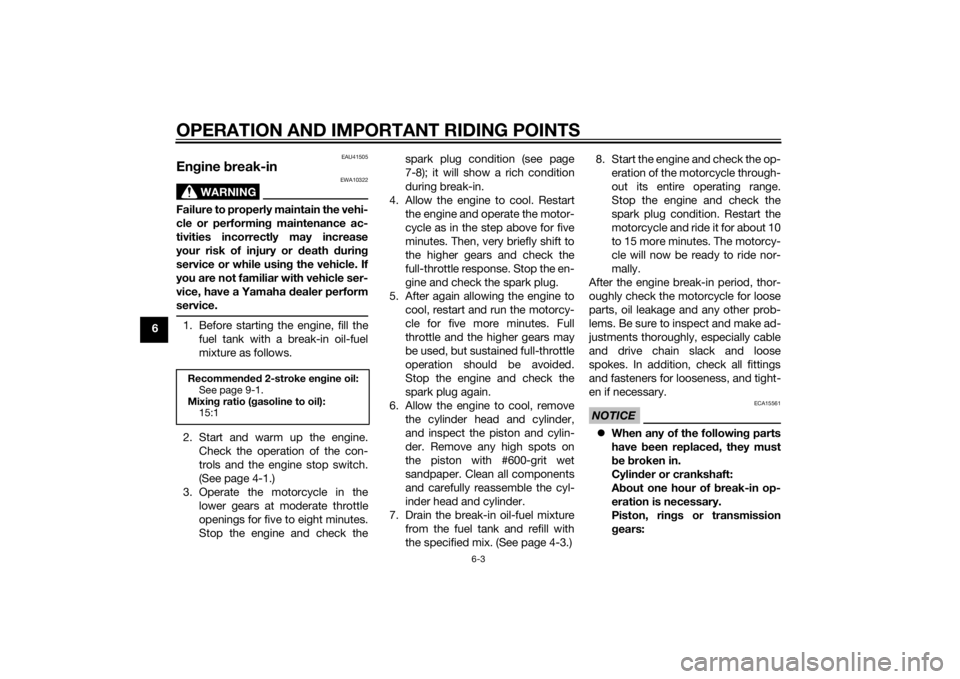
OPERATION AND IMPORTANT RIDING POINTS
6-3
6
EAU41505
Engine break-in
WARNING
EWA10322
Failure to properly maintain the vehi-
cle or performin g maintenance ac-
tivities incorrectly may increase
your risk of injury or death durin g
service or while usin g the vehicle. If
you are not familiar with vehicle ser-
vice, have a Yamaha d ealer perform
service.1. Before starting the engine, fill the fuel tank with a break-in oil-fuel
mixture as follows.
2. Start and warm up the engine. Check the operation of the con-
trols and the engine stop switch.
(See page 4-1.)
3. Operate the motorcycle in the lower gears at moderate throttle
openings for five to eight minutes.
Stop the engine and check the spark plug condition (see page
7-8); it will show a rich condition
during break-in.
4. Allow the engine to cool. Restart the engine and operate the motor-
cycle as in the step above for five
minutes. Then, very briefly shift to
the higher gears and check the
full-throttle response. Stop the en-
gine and check the spark plug.
5. After again allowing the engine to cool, restart and run the motorcy-
cle for five more minutes. Full
throttle and the higher gears may
be used, but sustained full-throttle
operation should be avoided.
Stop the engine and check the
spark plug again.
6. Allow the engine to cool, remove the cylinder head and cylinder,
and inspect the piston and cylin-
der. Remove any high spots on
the piston with #600-grit wet
sandpaper. Clean all components
and carefully reassemble the cyl-
inder head and cylinder.
7. Drain the break-in oil-fuel mixture from the fuel tank and refill with
the specified mix. (See page 4-3.) 8. Start the engine and check the op-
eration of the motorcycle through-
out its entire operating range.
Stop the engine and check the
spark plug condition. Restart the
motorcycle and ride it for about 10
to 15 more minutes. The motorcy-
cle will now be ready to ride nor-
mally.
After the engine break-in period, thor-
oughly check the motorcycle for loose
parts, oil leakage and any other prob-
lems. Be sure to inspect and make ad-
justments thoroughly, especially cable
and drive chain slack and loose
spokes. In addition, check all fittings
and fasteners for looseness, and tight-
en if necessary.
NOTICE
ECA15561
When any of the followin g parts
have been replaced , they must
b e broken in.
Cylin der or crankshaft:
A bout one hour of b reak-in op-
eration is necessary.
Piston, rin gs or transmission
g ears:
Recommen ded 2-stroke en gine oil:
See page 9-1.
Mixin g ratio ( gasoline to oil):
15:1
U1SN83E0.book Page 3 Monday, September 8, 2014 2:36 PM
Page 45 of 88
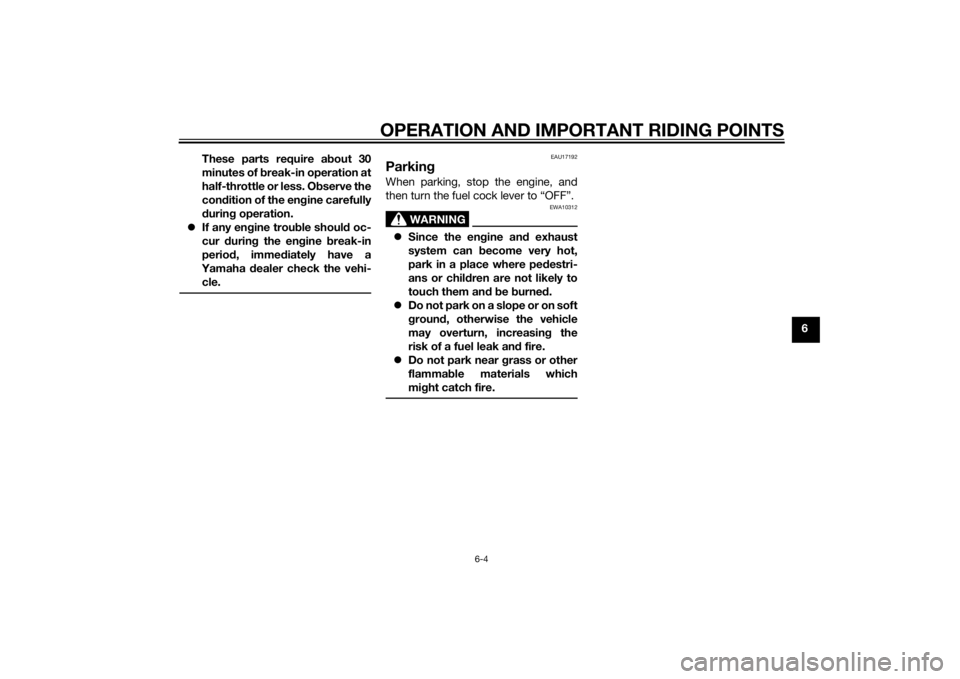
OPERATION AND IMPORTANT RIDING POINTS
6-4
6
These parts require a
bout 30
minutes of break-in operation at
half-throttle or less. O bserve the
con dition of the en gine carefully
d urin g operation.
If any en gine trou ble shoul d oc-
cur durin g the en gine break-in
period , imme diately have a
Yamaha dealer check the vehi-
cle.
EAU17192
Parkin gWhen parking, stop the engine, and
then turn the fuel cock lever to “OFF”.
WARNING
EWA10312
Since the en gine an d exhaust
system can b ecome very hot,
park in a place where ped estri-
ans or chil dren are not likely to
touch them an d b e burne d.
Do not park on a slope or on soft
groun d, otherwise the vehicle
may overturn, increasin g the
risk of a fuel leak an d fire.
Do not park near grass or other
flamma ble materials which
mi ght catch fire.
U1SN83E0.book Page 4 Monday, September 8, 2014 2:36 PM
Page 53 of 88

PERIODIC MAINTENANCE AND ADJUSTMENT
7-8
7
EAU19614
Checking the spark plugThe spark plug is an important engine
component, which is easy to check.
Since heat and deposits will cause any
spark plug to slowly erode, the spark
plug should be removed and checked
in accordance with the periodic main-
tenance and lubrication chart. In addi-
tion, the condition of the spark plug
can reveal the condition of the engine.
To remove the spark plu g
1. Remove the spark plug cap.
2. Remove the spark plug as shown, with a spark plug wrench available
at a Yamaha dealer. To check the spark plu
g
1. Check that the porcelain insulator around the center electrode of the
spark plug is a medium-to-light
tan (the ideal color when the vehi-
cle is ridden normally).
TIPIf the spark plug shows a distinctly dif-
ferent color, the engine could be oper-
ating improperly. Do not attempt to
diagnose such problems yourself. In-
stead, have a Yamaha dealer check
the vehicle.
2. Check the spark plug for electrodeerosion and excessive carbon or
other deposits, and replace it if
necessary.
3. Measure the spark plug gap with a wire thickness gauge and, if nec-
essary, adjust the gap to specifi-
cation.
1. Spark plug cap
1. Spark plug wrench
Specified spark plu g:
NGK/BR10EG
1. Spark plug gap
Spark plu g g ap:
0.5–0.6 mm (0.020–0.024 in)
U1SN83E0.book Page 8 Monday, September 8, 2014 2:36 PM
Page 54 of 88
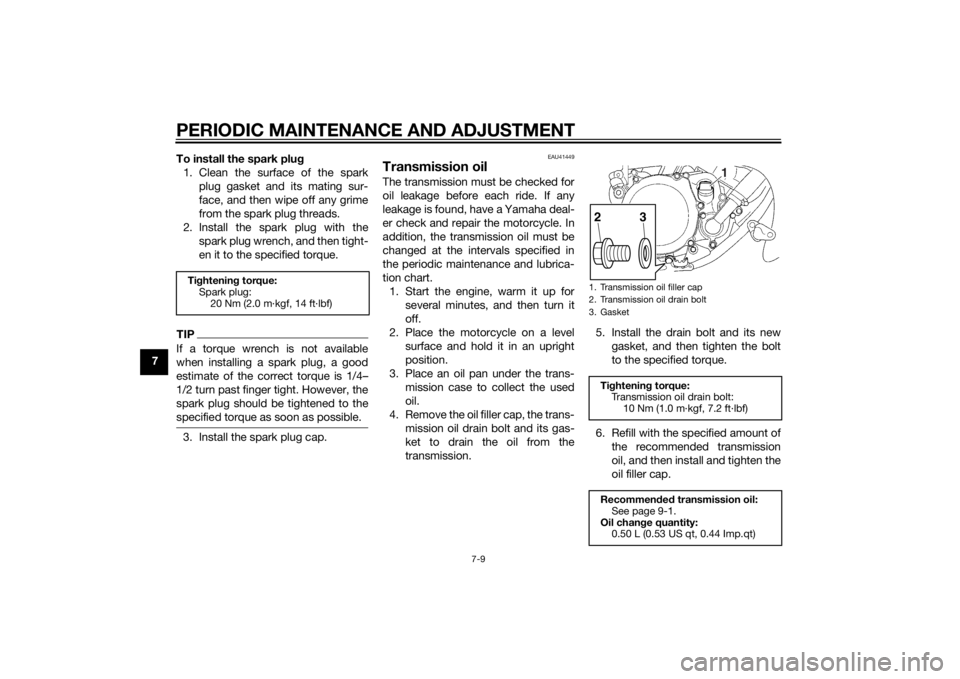
PERIODIC MAINTENANCE AND ADJUSTMENT
7-9
7To install the spark plu
g
1. Clean the surface of the spark plug gasket and its mating sur-
face, and then wipe off any grime
from the spark plug threads.
2. Install the spark plug with the spark plug wrench, and then tight-
en it to the specified torque.
TIPIf a torque wrench is not available
when installing a spark plug, a good
estimate of the correct torque is 1/4–
1/2 turn past finger tight. However, the
spark plug should be tightened to the
specified torque as soon as possible.3. Install the spark plug cap.
EAU41449
Transmission oilThe transmission must be checked for
oil leakage before each ride. If any
leakage is found, have a Yamaha deal-
er check and repair the motorcycle. In
addition, the transmission oil must be
changed at the intervals specified in
the periodic maintenance and lubrica-
tion chart.1. Start the engine, warm it up for several minutes, and then turn it
off.
2. Place the motorcycle on a level surface and hold it in an upright
position.
3. Place an oil pan under the trans- mission case to collect the used
oil.
4. Remove the oil filler cap, the trans- mission oil drain bolt and its gas-
ket to drain the oil from the
transmission. 5. Install the drain bolt and its new
gasket, and then tighten the bolt
to the specified torque.
6. Refill with the specified amount of the recommended transmission
oil, and then install and tighten the
oil filler cap.
Tightenin g torque:
Spark plug: 20 Nm (2.0 m·kgf, 14 ft·lbf)
1. Transmission oil filler cap
2. Transmission oil drain bolt
3. GasketTightenin g torque:
Transmission oil drain bolt:
10 Nm (1.0 m·kgf, 7.2 ft·lbf)
Recommen ded transmission oil:
See page 9-1.
Oil chan ge quantity:
0.50 L (0.53 US qt, 0.44 Imp.qt)
1
2
3
U1SN83E0.book Page 9 Monday, September 8, 2014 2:36 PM
Page 55 of 88

PERIODIC MAINTENANCE AND ADJUSTMENT
7-10
7
NOTICE
ECA10453
In or der to prevent clutch slip-
pa ge (since the transmission oil
also lu bricates the clutch), do
not mix any chemical additives.
Do not use oils with a d iesel
specification of “CD” or oils of a
hi gher quality than specifie d. In
a ddition, do not use oils lab eled
“ENERGY CONSERVING II” or
hi gher.
Make sure that no forei gn mate-
rial enters the transmission.7. Start the engine, and then let it idle for several minutes while checking
it for oil leakage. If oil is leaking,
immediately turn the engine off
and check for the cause.
EAU20071
CoolantThe coolant level should be checked
before each ride. In addition, the cool-
ant must be changed at the intervals
specified in the periodic maintenance
and lubrication chart.
EAUM1296
To check the coolant level1. Place the vehicle on a level sur- face and hold it in an upright posi-
tion.TIPThe coolant level must be
checked on a cold engine since
the level varies with engine tem-
perature.
Make sure that the vehicle is posi-
tioned straight up when checking
the coolant level. A slight tilt to the
side can result in a false reading.2. Remove the radiator cap and
check the coolant level in the radi-
ator. WARNING! Never attempt
to remove the ra diator cap
when the en gine is hot.
[EWA10382]
TIPThe coolant should be at the bottom of
the radiator filler neck. The level will
change with variation of engine tem-
perature.1. Radiator cap
1. Correct coolant level
1
1
U1SN83E0.book Page 10 Monday, September 8, 2014 2:36 PM
Page 56 of 88
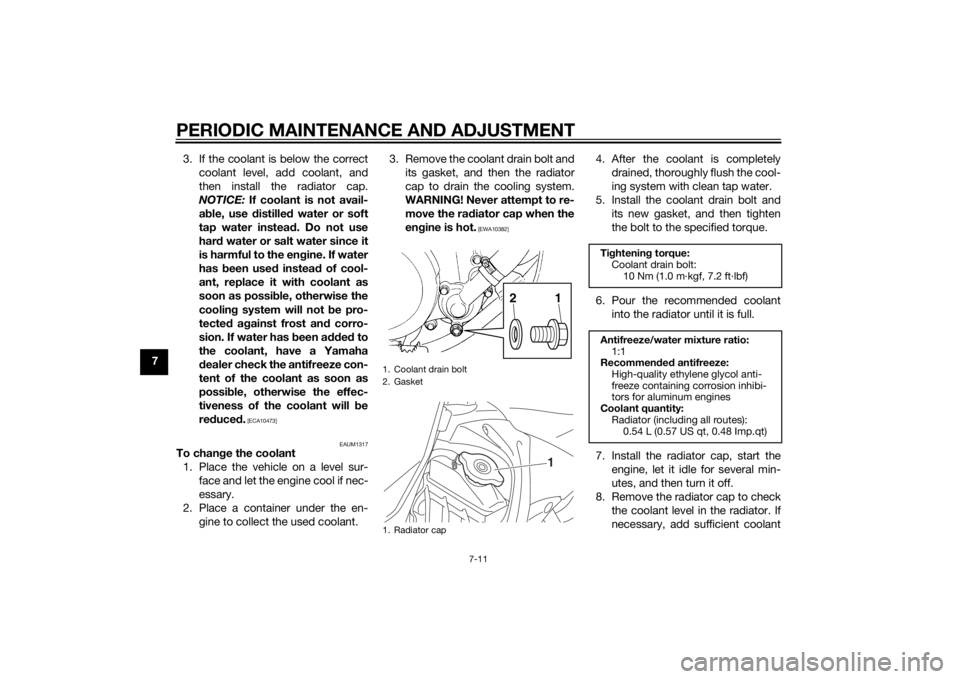
PERIODIC MAINTENANCE AND ADJUSTMENT
7-11
73. If the coolant is below the correct
coolant level, add coolant, and
then install the radiator cap.
NOTICE: If coolant is not avail-
a b le, use distille d water or soft
tap water instea d. Do not use
har d water or salt water since it
is harmful to the en gine. If water
has been used instead of cool-
ant, replace it with coolant as
soon as possi ble, otherwise the
coolin g system will not be pro-
tected against frost an d corro-
sion. If water has been adde d to
the coolant, have a Yamaha
d ealer check the antifreeze con-
tent of the coolant as soon as
possi ble, otherwise the effec-
tiveness of the coolant will be
re duce d.
[ECA10473]
EAUM1317
To change the coolant
1. Place the vehicle on a level sur- face and let the engine cool if nec-
essary.
2. Place a container under the en- gine to collect the used coolant. 3. Remove the coolant drain bolt and
its gasket, and then the radiator
cap to drain the cooling system.
WARNING! Never attempt to re-
move the ra diator cap when the
en gine is hot.
[EWA10382]
4. After the coolant is completely
drained, thoroughly flush the cool-
ing system with clean tap water.
5. Install the coolant drain bolt and its new gasket, and then tighten
the bolt to the specified torque.
6. Pour the recommended coolant into the radiator until it is full.
7. Install the radiator cap, start the engine, let it idle for several min-
utes, and then turn it off.
8. Remove the radiator cap to check the coolant level in the radiator. If
necessary, add sufficient coolant
1. Coolant drain bolt
2. Gasket
1. Radiator cap
1
2
1
Tightenin g torque:
Coolant drain bolt: 10 Nm (1.0 m·kgf, 7.2 ft·lbf)
Antifreeze/water mixture ratio: 1:1
Recommen ded antifreeze:
High-quality ethylene glycol anti-
freeze containing corrosion inhibi-
tors for aluminum engines
Coolant quantity: Radiator (including all routes):0.54 L (0.57 US qt, 0.48 Imp.qt)
U1SN83E0.book Page 11 Monday, September 8, 2014 2:36 PM
Page 57 of 88

PERIODIC MAINTENANCE AND ADJUSTMENT
7-12
7
until it reaches the bottom of the
radiator filler neck, and then install
the radiator cap.
9. Start the engine, and then check the vehicle for coolant leakage. If
coolant is leaking, have a Yamaha
dealer check the cooling system.
EAU48392
Cleanin g the air filter elementThe air filter element should be cleaned
or replaced at the intervals specified in
the periodic maintenance and lubrica-
tion chart. Clean or, if necessary, re-
place the air filter element more
frequently if you are riding in unusually
wet or dusty areas.
1. Remove the seat. (See page 4-7.)
2. Remove the air filter case cover as shown. 3. Remove the air filter element by
removing the wing bolt and its
washer.
4. Remove the sponge material from the air filter element frame.1. Air filter case cover
1. Wing bolt
2. Washer
3. Air filter element
U1SN83E0.book Page 12 Monday, September 8, 2014 2:36 PM